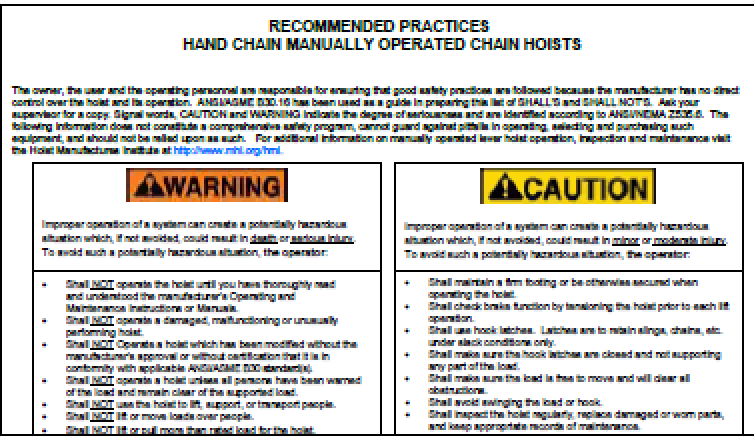
By Jean Feingold
Hoists are used to lift and lower items not easily lifted by a person, making material handling tasks much easier. Operating and maintaining hoists correctly is necessary to prevent injury to workers. Toward that end, MHI’s Hoist Manufacturers Institute (HMI) has recently updated two documents to help MHI members and other hoist owners, users and maintenance staff operate and maintain hoists safely.
“Hoist Operator’s Manual” and “Recommended Practices for Electric and Air Powered Hoists” are designed to supplement company safety practices and hoist manufacturers’ instructions. Both documents can be downloaded at no charge from the MHI website.
Recognized as the leading authority and principal resource in the hoist industry, HMI members are the leading suppliers of hoisting equipment. Products they offer include hand chain hoists, ratchet lever hoists, powered chain hoists, trolleys and powered wire rope hoists. Comprised of representatives from member companies, committee members work together to create technical publications promoting the safe use of hoist products, and their proper inspection and maintenance recommendations. More information on HMI and its members can be found at www.mhi.org/hmi.
The revised hoist documents
The “Hoist Operator’s Manual” is available at mhi.org/free/4570. It lists hoist types, covers the duties and responsibilities of hoist operators, describes the motions of hoists and trolleys and explains the operation of manual, electric and air powered hoists. It also includes recommended practices for hoist operations. Perhaps most importantly, the manual enumerates and explains the need for regular inspection, maintenance and repair of hoists.
An example of a possible problem that could be prevented by following the guidelines in the HMI documents is doing visual inspection of the lifting medium. “If the operator sees a frayed wire rope or elongated chain link before operating it, the probability of having a heavy load dropped because of a broken rope or chain is eliminated,” explained HMI member Brian Stephens, senior product manager at MHI member Demag Cranes and Components Corp. “The hoist operator is responsible for regular visual inspections of the equipment.”
“Recommended Practices for Electric and Air Powered Hoists” discusses what to do and what to avoid when using powered hoists. There are two sections: Warnings and Cautions. These are differentiated based on the severity of the potential hazards.
Warnings cover incorrect practices that could result in serious injury or death if not avoided.
 MHI Solutions Improving Supply Chain Performance
MHI Solutions Improving Supply Chain Performance